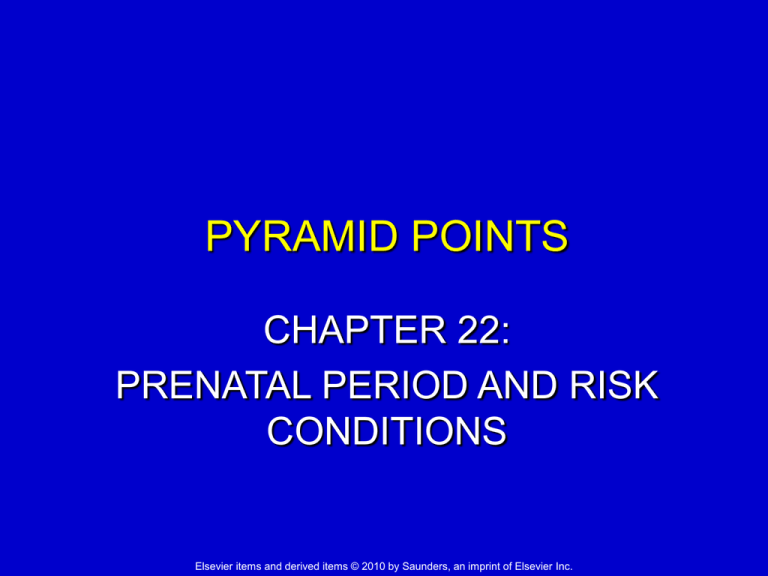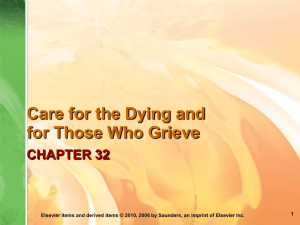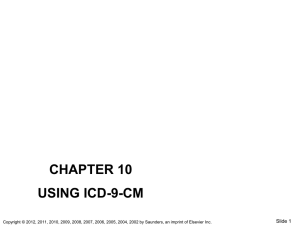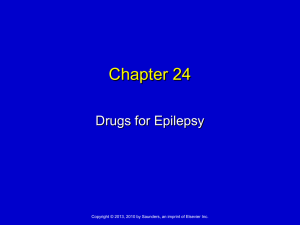
PYRAMID POINTS
CHAPTER 22:
PRENATAL PERIOD AND RISK
CONDITIONS
Elsevier items and derived items © 2010 by Saunders, an imprint of Elsevier Inc.
PYRAMID POINTS
I. Physiological Maternal Changes
Cardiovascular system
• Pulse may increase 10 beats/minute
• Blood pressure may decrease in second trimester
Respiratory system: oxygen consumption increases by
15% to 20%
Gastrointestinal system
• Nausea and vomiting may occur from first through third
months
• Constipation may occur
• Hemorrhoids may develop
Renal system: frequency of urination increases in first
and third trimesters
Endocrine system: basal metabolic rate rises
MATERNITY NURSING:
Prenatal Period and Risk Conditions
Elsevier items and derived items © 2010 by Saunders, an imprint of Elsevier Inc.
22-2
PYRAMID POINTS
I. Physiological Maternal Changes
(continued)
Reproductive system
• Uterus enlarges with increase in number and size of
•
•
•
•
•
blood vessels
Cervix becomes shorter, more elastic, and larger in
diameter
Maturation of new follicles is blocked
Increases in vaginal secretions
Breast size increases
Colostrum may appear from breast
MATERNITY NURSING:
Prenatal Period and Risk Conditions
Elsevier items and derived items © 2010 by Saunders, an imprint of Elsevier Inc.
22-3
PYRAMID POINTS
I. Physiological Maternal Changes
(continued)
Integumentary system (skin)
• Increased pigmentation
• Appearance of linea nigra
• Chloasma may appear
• Striae may appear
• Vascular spider nevi may appear
Skeletal system: center of gravity changes
Metabolism
• Metabolic function increases
• Body weight increases
MATERNITY NURSING:
Prenatal Period and Risk Conditions
Elsevier items and derived items © 2010 by Saunders, an imprint of Elsevier Inc.
22-4
PYRAMID POINTS
II. Psychological Maternal Changes
Ambivalence
Acceptance
Emotional lability
Body image changes
Relationship with fetus
MATERNITY NURSING:
Prenatal Period and Risk Conditions
Elsevier items and derived items © 2010 by Saunders, an imprint of Elsevier Inc.
22-5
PYRAMID POINTS
III. Discomforts of Pregnancy
Nausea and vomiting
Syncope
Urinary urgency and
frequency
Breast tenderness
Increased vaginal
discharge
Nasal stuffiness
Fatigue
Heartburn
Ankle edema
Varicose veins
Headache
Hemorrhoids
Constipation
Backache
Leg cramps
Shortness of breath and dyspnea
MATERNITY NURSING:
Prenatal Period and Risk Conditions
Elsevier items and derived items © 2010 by Saunders, an imprint of Elsevier Inc.
22-6
PYRAMID POINTS
IV. Laboratory Tests
Blood type and Rh factor
• Mother is Rh-negative and has negative antibody
screen
Will need to repeat antibody screens
Should be given Rho(D) immune globulin (RhoGAM)
within 72 hours of birth of first baby when detected
With every other pregnancy, should be given RhoGAM
at 28 weeks’ gestation and within 72 hours of birth of
baby
MATERNITY NURSING:
Prenatal Period and Risk Conditions
Elsevier items and derived items © 2010 by Saunders, an imprint of Elsevier Inc.
22-7
PYRAMID POINTS
IV. Laboratory Tests (continued)
Rubella titer
• Client with negative titer (<1:8) at risk of contracting
rubella, which can be transmitted to fetus and cause
birth anomalies; thus titer should be assessed prior
to conception
• If negative titer, client must be using effective birth
control at time of immunization, must be counseled
not be become pregnant for 3 months following
immunization
MATERNITY NURSING:
Prenatal Period and Risk Conditions
Elsevier items and derived items © 2010 by Saunders, an imprint of Elsevier Inc.
22-8
PYRAMID POINTS
IV. Laboratory Tests (continued)
Hemoglobin and hematocrit levels
Papanicolaou smear
Sexually transmitted infections
Sickle cell screening
Tuberculin skin test
• Positive test indicates need for chest x-ray to rule out
active disease
In pregnant client, x-ray cannot be performed until
after 20 weeks’ gestation
Hepatitis B surface antigens
• Recommended for all women because of prevalence of
disease in general population
Urinalysis and urine culture
• Levels of 2+ to 4+ protein in urine may indicate infection or
preeclampsia
MATERNITY NURSING:
Prenatal Period and Risk Conditions
Elsevier items and derived items © 2010 by Saunders, an imprint of Elsevier Inc.
22-9
PYRAMID POINTS
V. Diagnostic Tests
Ultrasonography
• Outlines, identifies fetal and maternal structures
• Assists in confirming gestational age and estimated date of
confinement
Alpha-fetoprotein screening
• Can detect neural tube defects, such as spina bifida and
Down syndrome
• Maternal blood sample drawn at 15 to 18 weeks’ gestation
Chorionic villus sampling
• Detects genetic abnormalities by sampling chorionic villus
tissue at 8 to 12 weeks’ gestation
Kick counts (fetal movement counting)
MATERNITY NURSING:
Prenatal Period and Risk Conditions
Elsevier items and derived items © 2010 by Saunders, an imprint of Elsevier Inc.
22-10
PYRAMID POINTS
V. Diagnostic Tests (continued)
Amniocentesis
• Aspiration of amniotic fluid may be done from
13 to 14 weeks’ gestation
• Used to determine genetic disorders, metabolic
defects, fetal lung maturity
• Risks include maternal hemorrhage, infection,
abruptio placentae, premature rupture of membranes
Fern test
• Microscopic slide test to determine presence of
amniotic fluid leakage
MATERNITY NURSING:
Prenatal Period and Risk Conditions
Elsevier items and derived items © 2010 by Saunders, an imprint of Elsevier Inc.
22-11
PYRAMID POINTS
V. Diagnostic Tests (continued)
Nitrazine test
• Determines presence of amniotic fluid in vaginal
secretions; shades of blue indicate that membranes
probably ruptured
Nonstress test
• Performed to assess placental function and oxygenation
• Assesses fetal well-being
Contraction stress test
• Performed to assess placental oxygenation and function
• Assesses fetal ability to tolerate labor, fetal well-being
MATERNITY NURSING:
Prenatal Period and Risk Conditions
Elsevier items and derived items © 2010 by Saunders, an imprint of Elsevier Inc.
22-12
PYRAMID POINTS
VI. Nutrition
General guidelines
• Average expected weight gain during pregnancy
25 to 35 lb
• Encourage diets high in folic acid, with increases of
about 300 cal/day; increased intake of fluids of at
least eight glasses/day; no sodium restrictions
Vegetarianism
Lactose intolerance
Pica
Cultural considerations
MATERNITY NURSING:
Prenatal Period and Risk Conditions
Elsevier items and derived items © 2010 by Saunders, an imprint of Elsevier Inc.
22-13
PYRAMID POINTS
VII. Abortion
Description
• Pregnancy that ends before 20 weeks’ gestation,
spontaneously or electively
Types
• Spontaneous: pregnancy ends because of natural
•
•
•
•
causes
Induced: therapeutic or elective reasons for
terminating pregnancy
Threatened: developing spontaneous abortion
Inevitable: threatened loss that cannot be prevented
Incomplete: loss of some products of conception and
retention of others
MATERNITY NURSING:
Prenatal Period and Risk Conditions
Elsevier items and derived items © 2010 by Saunders, an imprint of Elsevier Inc.
22-14
PYRAMID POINTS
VII. Abortion (continued)
Types (continued)
• Complete: loss of all products of conception
• Missed: retention of products of conception in utero after
fetal death
• Habitual: spontaneous abortions in three or more
successive pregnancies
Data collection
• Spontaneous vaginal bleeding; passage of clots or tissue
through vagina; low uterine cramping or contractions
Interventions
• Count perineal pads to evaluate blood loss and save
expelled tissues and clots
• Educate client, family regarding dilation and curettage as
prescribed
MATERNITY NURSING:
Prenatal Period and Risk Conditions
Elsevier items and derived items © 2010 by Saunders, an imprint of Elsevier Inc.
22-15
PYRAMID POINTS
VIII. Human Immunodeficiency Virus (HIV) and
Acquired Immunodeficiency Syndrome (AIDS)
Description
• HIV-infected women first may demonstrate symptoms at
some point during pregnancy or develop life-threatening
infections during pregnancy
• Zidovudine (AZT) recommended for prevention of
maternal-fetal HIV transmission, administered by mouth
after 14 weeks’ gestation, intravenously (IV) during labor, in
form of syrup to neonate after birth for 6 weeks as
prescribed
Transmission
• Perinatal exposure of infant to infected maternal secretions
at delivery and/or through breast-feeding
Risk to mother: vulnerability to infections
MATERNITY NURSING:
Prenatal Period and Risk Conditions
Elsevier items and derived items © 2010 by Saunders, an imprint of Elsevier Inc.
22-16
PYRAMID POINTS
VIII. Human Immunodeficiency Virus and Acquired
Immunodeficiency Syndrome (continued)
Diagnosis
• Tests include enzyme-linked immunosorbent assay
(ELISA), Western blot test, immunofluorescence assay
(IFA)
Data collection
• Stage 1: fever, lymphadenopathy, headache
• Stage 2: asymptomatic of active infection, but may present
with herpes zoster or transient thrombocytopenia
• Stage 3: immune dysfunction, integumentary and
gynecological problems common
• Stage 4: advanced HIV infection, increased vulnerability to
bacterial infections, development of opportunistic infections
MATERNITY NURSING:
Prenatal Period and Risk Conditions
Elsevier items and derived items © 2010 by Saunders, an imprint of Elsevier Inc.
22-17
PYRAMID POINTS
VIII. Human Immunodeficiency Virus and
Acquired Immunodeficiency Syndrome
(continued)
Interventions
• Prenatal period: avoid procedures that increase risk
of perinatal transmission, such as amniocentesis
• Intrapartum period: avoid use of scalp electrodes,
episiotomy, administration of oxytocin (Pitocin); all
increase maternal blood exposure and risk of
transmission to fetus
• Postpartum period: if mother immunocompromised,
place in protective isolation, restrict breast-feeding
MATERNITY NURSING:
Prenatal Period and Risk Conditions
Elsevier items and derived items © 2010 by Saunders, an imprint of Elsevier Inc.
22-18
PYRAMID POINTS
VIII. Human Immunodeficiency Virus and
Acquired Immunodeficiency Syndrome
(continued)
Neonate and HIV
• Neonate can room with mother
• Bathe neonate carefully before any invasive procedure
• Administer zidovudine (AZT) to newborn infant as
prescribed for first 6 weeks of life
• All HIV-exposed newborn infants should be treated with
medications to prevent infection by Pneumocystis jiroveci
• No live immunizations should be given to infants at risk for
HIV
MATERNITY NURSING:
Prenatal Period and Risk Conditions
Elsevier items and derived items © 2010 by Saunders, an imprint of Elsevier Inc.
22-19
PYRAMID POINTS
IX. Anemia
Description
• Predisposes client to postpartum infection
Data collection
• Fatigue, headache, pallor, tachycardia, hemoglobin
level lower than 10 mg/dL, hematocrit level lower
than 30 g/dL
Interventions
• Monitor hemoglobin and hematocrit levels every
2weeks
• Be sure client is instructed to take iron and folic acid
supplements
MATERNITY NURSING:
Prenatal Period and Risk Conditions
Elsevier items and derived items © 2010 by Saunders, an imprint of Elsevier Inc.
22-20
PYRAMID POINTS
X. Cardiac Disease
Description
• Mother with cardiac disease may be physiologically
unable to cope with added plasma volume, increased
cardiac output, especially during last weeks of
second trimester
Maternal cardiac disease risk groups
• Congenital heart disorders
• Valvular disease
• Cardiomyopathy
• Dysrhythmias
• Chronic hypertension
• Heart failure
MATERNITY NURSING:
Prenatal Period and Risk Conditions
Elsevier items and derived items © 2010 by Saunders, an imprint of Elsevier Inc.
22-21
PYRAMID POINTS
X. Cardiac Disease (continued)
Functional classification of heart disease
• Class I: cardiac disease without limitations on physical
activity
• Class II: cardiac disease with slight limitation on physical
activity; comfortable at rest; ordinary activity may cause
fatigue, palpitations, dyspnea, pain
• Class III: cardiac disease with marked limitations on
physical activity; comfortable at rest; less than ordinary
activity may cause fatigue, palpitations, dyspnea, pain
• Class IV: cardiac disease that results in inability to carry
out any physical activity without discomfort; symptoms of
heart failure or angina, even at rest
MATERNITY NURSING:
Prenatal Period and Risk Conditions
Elsevier items and derived items © 2010 by Saunders, an imprint of Elsevier Inc.
22-22
PYRAMID POINTS
X. Cardiac Disease (continued)
Data collection
• Monitor for cough, dyspnea, palpitations and tachycardia,
peripheral edema, chest pain and signs of respiratory
infection, congestive heart failure, pulmonary edema
Interventions
• Collect data, monitor for signs of cardiac disease, as well
as condition of fetus
• During labor
Monitor vital signs frequently
Place client on cardiac monitor
Maintain bedrest
Client in side-lying position, with head and shoulders
elevated
Administer oxygen as needed (PRN)
MATERNITY NURSING:
Prenatal Period and Risk Conditions
Elsevier items and derived items © 2010 by Saunders, an imprint of Elsevier Inc.
22-23
PYRAMID POINTS
XI. Chronic Hypertension
High blood pressure that occurs before pregnancy, is
diagnosed prior to the 20th week of gestation, or is diagnosed
for the first time during pregnancy and persists beyond 42 days
postpartum
Data collection
• Headaches
• Visual changes
• Elevated blood pressure, 140/90 or higher
• Delayed fetal growth
Interventions
• Monitor blood pressure, intake and output
• Monitor fetal activity, fetal growth
• Encourage frequent rest periods, especially positioned on
left side
• Administer antihypertensives as ordered
MATERNITY NURSING:
Prenatal Period and Risk Conditions
Elsevier items and derived items © 2010 by Saunders, an imprint of Elsevier Inc.
22-24
PYRAMID POINTS
XII. Diabetes Mellitus
Description
• During first trimester, maternal insulin needs
decrease
• During second and third trimesters, maternal insulin
needs increase
• Fetus produces own insulin and pulls glucose from
mother, predisposing mother to hypoglycemia
• Newborn infant of diabetic mother at risk for
hypoglycemia, hyperbilirubinemia, respiratory
distress syndrome, hypocalcemia, congenital
anomalies
MATERNITY NURSING:
Prenatal Period and Risk Conditions
Elsevier items and derived items © 2010 by Saunders, an imprint of Elsevier Inc.
22-25
PYRAMID POINTS
XII. Diabetes Mellitus (continued)
Gestational diabetes mellitus
• Screen all pregnant women between 24 and
28 weeks’ gestation
• Frequently can be treated by diet alone; some may
need insulin
Predisposing conditions to gestational diabetes
Data collection
• Signs similar to those of diabetes mellitus in
nonpregnant women
MATERNITY NURSING:
Prenatal Period and Risk Conditions
Elsevier items and derived items © 2010 by Saunders, an imprint of Elsevier Inc.
22-26
PYRAMID POINTS
XII. Diabetes Mellitus (continued)
Interventions
• Include diet, insulin, exercise, monitoring blood
glucose levels
• Monitor for signs of hyperglycemia, glycosuria,
ketonuria, hypoglycemia
Interventions during labor
• Monitor fetal status continuously for signs of distress
Interventions during postpartum period
• Monitor mother for hypoglycemic reaction, signs of
postpartum hemorrhage
MATERNITY NURSING:
Prenatal Period and Risk Conditions
Elsevier items and derived items © 2010 by Saunders, an imprint of Elsevier Inc.
22-27
PYRAMID POINTS
XIII. Disseminated Intravascular Coagulation
Description
• Rapid and extensive formation of clot causes platelets
and clotting factors to be depleted, leading to bleeding
and potential vascular occlusion of organs from
thromboembolus formation
Predisposing conditions
• Abruptio placentae, intrauterine fetal death, amniotic
fluid embolism, gestational hypertension, liver disease,
sepsis
Data collection
• Monitor for signs of uncontrolled bleeding, including
ecchymosis, bruising, melena, hematuria, signs of
shock, increased prothrombin time and partial
thromboplastin time
Interventions
• Monitor vital signs; monitor for bleeding, shock
MATERNITY NURSING:
Prenatal Period and Risk Conditions
Elsevier items and derived items © 2010 by Saunders, an imprint of Elsevier Inc.
22-28
PYRAMID POINTS
XIV. Ectopic Pregnancy
Description
• Pregnancy that occurs in site other than uterus, with
implantation usually occurring in fallopian tubes
Data collection
• Rupture: assessment includes increased pain,
referred shoulder pain, signs of shock
Interventions
• Monitor for bleeding; initiate measures to prevent
shock
• Administer Rh immune globulin in Rho(D)-negative
women
MATERNITY NURSING:
Prenatal Period and Risk Conditions
Elsevier items and derived items © 2010 by Saunders, an imprint of Elsevier Inc.
22-29
PYRAMID POINTS
XV. Endometritis
Description
• Infection of lining of uterus following delivery caused
by bacteria that invade uterus at placental site
Data collection
• Includes signs of infection; prolonged, severe
afterpains; backache, tender, large uterus; foul odor
to lochia, or reddish brown lochia
Interventions
• Position client in Fowler’s position
• Educate mother about proper handwashing
technique
• IV antibiotics as prescribed
MATERNITY NURSING:
Prenatal Period and Risk Conditions
Elsevier items and derived items © 2010 by Saunders, an imprint of Elsevier Inc.
22-30
PYRAMID POINTS
XVI. Fetal Death in Utero
Description
• Death of fetus after the 20th week of gestation and before birth
Data collection
• Absence of fetal movement, absence of fetal heart tones,
maternal weight loss, lack of fetal growth or decrease in fundal
height
Interventions
• Prepare for delivery of fetus
• Support client’s decision about labor, birth, and postpartum
•
•
•
•
•
period
Facilitate grieving process
Allow parents to hold infant after birth
Allow parents to name the infant
Expect, accept parental behaviors, such as anger and hostility
Refer parents to appropriate support group(s)
MATERNITY NURSING:
Prenatal Period and Risk Conditions
Elsevier items and derived items © 2010 by Saunders, an imprint of Elsevier Inc.
22-31
PYRAMID POINTS
XVII. Hepatitis B
Description
• Viral infection; increases risk of prematurity, low birth
weight, neonatal death if present in mother
• Hepatitis B transmitted through blood, saliva, vaginal
secretions, semen, breast milk, across placental barrier
Interventions
• Minimize risk for intrapartum ascending infections
• Bathe, clean neonate immediately after birth
• Administer hepatitis immune globulin and hepatitis B
vaccine soon after birth; then administer at 1 and
6 months of age
• Support breast-feeding (not contraindicated)
MATERNITY NURSING:
Prenatal Period and Risk Conditions
Elsevier items and derived items © 2010 by Saunders, an imprint of Elsevier Inc.
22-32
PYRAMID POINTS
XVIII. Hematoma
Description
• Escape of blood into tissues of reproductive tract after
delivery
Data collection
• Abnormal, severe pain; pressure in perineal area;
palpable, sensitive tumor in perineal area; inability to void;
decreased hemoglobin and hematocrit levels; signs of
shock, including pallor, tachycardia, hypotension
Interventions
• Apply ice to hematoma site
• Administer analgesics PRN
• Monitor for signs of infection; if present, administer
antibiotics as prescribed
MATERNITY NURSING:
Prenatal Period and Risk Conditions
Elsevier items and derived items © 2010 by Saunders, an imprint of Elsevier Inc.
22-33
PYRAMID POINTS
XIX. Hydatidiform Mole
Description
• Developmental anomaly of the placenta that changes
chorionic villi into mass of clear vesicles
Data collection
• Nondetectable fetal heart rate
• Vaginal bleeding
• Fundal height greater than expected for gestational date
• Snowstorm pattern on ultrasonogram
Interventions
• Prepare mother for uterine evacuation; send tissue to
laboratory for evaluation
• Monitor for postprocedure hemorrhage and infection
MATERNITY NURSING:
Prenatal Period and Risk Conditions
Elsevier items and derived items © 2010 by Saunders, an imprint of Elsevier Inc.
22-34
PYRAMID POINTS
XX. Hyperemesis Gravidarum
Description
• Intractable nausea, vomiting that persists beyond first
trimester; causes disturbances in nutrition, electrolytes,
fluid balance
Data collection
• Nausea most pronounced on arising; occurs at other times
during day; may become persistent, with subsequent
weight loss and electrolyte imbalances
Interventions
• Monitor fetal heart rate, activity, growth
• Small, frequent low-fat meals of easily digestible
carbohydrates
MATERNITY NURSING:
Prenatal Period and Risk Conditions
Elsevier items and derived items © 2010 by Saunders, an imprint of Elsevier Inc.
22-35
PYRAMID POINTS
XXI. Incompetent Cervix
Description
• Premature dilation of the cervix; occurs most often in
fourth or fifth month of pregnancy
Data collection
• Fetal membranes visible through cervix
Interventions
• Provide bedrest, hydration, tocolysis as prescribed
• Prepare for cervical cerclage
• Monitor for contractions, rupture of the membranes,
signs of infection postprocedure
MATERNITY NURSING:
Prenatal Period and Risk Conditions
Elsevier items and derived items © 2010 by Saunders, an imprint of Elsevier Inc.
22-36
PYRAMID POINTS
XXII. Infections
Toxoplasmosis
• Transmitted to mother through raw meat or handling
of cat litter of infected cats
• Organism crosses placenta to fetus; may cause
spontaneous abortion in first trimester
Rubella (German measles)
• Teratogenic in first trimester as organism crosses
placenta, causing congenital defects of eyes, heart,
brain
MATERNITY NURSING:
Prenatal Period and Risk Conditions
Elsevier items and derived items © 2010 by Saunders, an imprint of Elsevier Inc.
22-37
PYRAMID POINTS
XXII. Infections (continued)
Cytomegalovirus
• Organism transmitted through personal contact;
crosses placenta; fetus may also become infected
during passage through birth canal
• Diagnosis of neonatal infection made by urinary
testing
• If present, may cause:
Intrauterine growth restriction
Hepatosplenomegaly
Jaundice
Mental restriction
Blindness
Hearing loss
Seizures
MATERNITY NURSING:
Prenatal Period and Risk Conditions
Elsevier items and derived items © 2010 by Saunders, an imprint of Elsevier Inc.
22-38
PYRAMID POINTS
XXII. Infections (continued)
Genital herpes
• Virus transmitted to fetus during birth through
infected vagina or via ascending infection after
rupture of membranes; can cause death or severe
neurological impairment in newborn
• If mother has active herpes lesions:
Delivery of fetus is via cesarean section
If lesions are only in anal, perineal, or inner thigh area,
but not vaginal area, then delivery can occur vaginally
with strict precautions to protect fetus
MATERNITY NURSING:
Prenatal Period and Risk Conditions
Elsevier items and derived items © 2010 by Saunders, an imprint of Elsevier Inc.
22-39
PYRAMID POINTS
XXII. Infections (continued)
Group B Streptococcus
• Leading cause of life-threatening perinatal infections
• Transmitted to fetus during vaginal delivery; can lead
to infections of newborn such as sepsis, pneumonia,
meningitis
• Mother diagnosed via vaginal and rectal cultures
between 35 and 37 weeks’ gestation; if present,
antibiotics prescribed to mother during labor and
birth, with potential IV antibiotic administration to
infected infants
MATERNITY NURSING:
Prenatal Period and Risk Conditions
Elsevier items and derived items © 2010 by Saunders, an imprint of Elsevier Inc.
22-40
PYRAMID POINTS
XXIII. Multiple Gestation
Description
• Results from double ovulation (fraternal or dizygotic)
or splitting of fertilized egg (identical or monozygotic)
Data collection
• Excessive weight gain, with uterus large for
gestational age
• Auscultation of more than one fetal heart rate
Interventions
• Monitor fetal heart rates, activity, growth
• Monitor for cervical changes, signs of preterm labor
MATERNITY NURSING:
Prenatal Period and Risk Conditions
Elsevier items and derived items © 2010 by Saunders, an imprint of Elsevier Inc.
22-41
PYRAMID POINTS
XXIV. Gestational Hypertension (GH)
Description and types
• Acute hypertensive state that develops after 20th
week of gestation
• Condition can be mild or severe; can progress to
eclampsia, characterized by presence of seizures
Data collection
• Mild: elevated blood pressure, usually 15 to 30 mm
Hg above baseline; weight gain of 1 lb/week or more
in last trimester; mild, generalized edema; proteinuria
of 1+ to 2+
MATERNITY NURSING:
Prenatal Period and Risk Conditions
Elsevier items and derived items © 2010 by Saunders, an imprint of Elsevier Inc.
22-42
PYRAMID POINTS
XXIV. Gestational Hypertension (GH) (continued)
Data collection (continued)
• Severe: severe hypertension, systolic blood pressure at
least 160 mm Hg or diastolic at least 110 mm Hg; massive,
generalized edema; weight gain; proteinuria 3+ to 4+;
oliguria; visual disturbances; headache; HELLP syndrome
of laboratory hemolysis, elevated liver enzyme levels, low
platelet count
• Eclampsia: characterized by generalized seizures
Predisposing conditions
• Chronic conditions such as renal disease, hypertension,
diabetes mellitus
• Primigravida, especially women younger than 19 years or
older than 40 years of age
MATERNITY NURSING:
Prenatal Period and Risk Conditions
Elsevier items and derived items © 2010 by Saunders, an imprint of Elsevier Inc.
22-43
PYRAMID POINTS
XXIV. Gestational Hypertension (GH) (continued)
Complications of GH
• Hematological conditions, such as disseminated
intravascular coagulation, thrombocytopenia
• Placental conditions, such as abruptio placentae, placental
insufficiency
• Intrauterine growth restriction, intrauterine fetal death
Interventions for mild hypertension
• Close monitoring of blood pressure
• Frequent rest periods
• Administer antihypertensives as prescribed
• Monitor renal function, especially for proteinuria, intake and
output
MATERNITY NURSING:
Prenatal Period and Risk Conditions
Elsevier items and derived items © 2010 by Saunders, an imprint of Elsevier Inc.
22-44
PYRAMID POINTS
XXIV. Gestational Hypertension (GH)
(continued)
Interventions for mild preeclampsia
• Implement interventions as noted for mild
•
•
•
•
hypertension
Monitor neurological status, especially for signs of
impending seizure
Monitor for deep tendon reflexes, presence of clonus
Monitor for HELLP: laboratory diagnosis for severe
preeclampsia
No-added-salt diet, with increase in dietary protein
and carbohydrates
MATERNITY NURSING:
Prenatal Period and Risk Conditions
Elsevier items and derived items © 2010 by Saunders, an imprint of Elsevier Inc.
22-45
PYRAMID POINTS
XXIV. Gestational Hypertension (GH)
(continued)
Interventions for severe preeclampsia
• Implement interventions as noted for mild
hypertension and mild preeclampsia
• Administer magnesium sulfate as prescribed
• Monitor for signs of magnesium toxicity, including
BURP: decreased blood pressure; decreased urinary
output; respiratory depression; depressed or absent
patellar reflex
• Keep calcium gluconate antidote at bedside at all
times
MATERNITY NURSING:
Prenatal Period and Risk Conditions
Elsevier items and derived items © 2010 by Saunders, an imprint of Elsevier Inc.
22-46
PYRAMID POINTS
XXIV. Gestational Hypertension (GH)
(continued)
Eclampsia
• Diagnosed when seizures occur
• Provide care as with any seizure; monitor
fetal heart rate and contractions
• Administer magnesium sulfate as
prescribed
• Prepare for delivery of fetus
MATERNITY NURSING:
Prenatal Period and Risk Conditions
Elsevier items and derived items © 2010 by Saunders, an imprint of Elsevier Inc.
22-47
PYRAMID POINTS
XXV. Sexually Transmitted Infections
Chlamydia
• Associated with increased risk for premature births,
•
•
•
•
stillbirths, neonatal conjunctivitis, newborn
chlamydial pneumonia
Mother is usually asymptomatic but may have
bleeding between periods or after coitus, as well as
dysuria and pelvic pain
If present, ensure that sexual partner(s) are treated
Instruct mother about medication for neonate, if
prescribed
Administer appropriate eye prophylaxis to neonate
MATERNITY NURSING:
Prenatal Period and Risk Conditions
Elsevier items and derived items © 2010 by Saunders, an imprint of Elsevier Inc.
22-48
PYRAMID POINTS
XXV. Sexually Transmitted Infections (continued)
Syphilis
• Transmission by physical contact with syphilitic lesions
• Infection may cause abortion or premature labor; passed to
fetus after fourth month of pregnancy as congenital syphilis
• If organism present, as evidenced on venereal disease
research laboratory or rapid plasmin reagin blood testing,
administer antibiotics as prescribed, including to partner
Gonorrhea
• Transmission by sexual intercourse; may be transmitted to
newborn’s eyes during delivery, causing ophthalmia
neonatorum
• Culture for gonorrhea should be done during first prenatal
visit; if infection present, treat mother and partner(s)
• Administer eye prophylaxis to neonate as ordered
MATERNITY NURSING:
Prenatal Period and Risk Conditions
Elsevier items and derived items © 2010 by Saunders, an imprint of Elsevier Inc.
22-49
PYRAMID POINTS
XXV. Sexually Transmitted Infections
(continued)
Condylomata acuminata (venereal warts)
• Caused by HPV; transmitted through sexual contact
• Warts—may be small to large growths on genitals
• Cervical changes associated with cervical
malignancies; thus lesions are removed with
cytotoxic agents, cryotherapy, laser
• All women should have yearly Pap smears
MATERNITY NURSING:
Prenatal Period and Risk Conditions
Elsevier items and derived items © 2010 by Saunders, an imprint of Elsevier Inc.
22-50
PYRAMID POINTS
XXV. Sexually Transmitted Infections
(continued)
Bacterial vaginosis
• Transmitted via sexual contact; associated with
premature labor and birth
• “Fishy odor” to vaginal secretions
• Administer oral metronidazole (Flagyl) as prescribed
to mother and partner(s)
MATERNITY NURSING:
Prenatal Period and Risk Conditions
Elsevier items and derived items © 2010 by Saunders, an imprint of Elsevier Inc.
22-51
PYRAMID POINTS
XXV. Sexually Transmitted Infections
(continued)
Vaginal candidiasis
• Candida albicans most common cause; often
precipitated by use of antibiotics, diabetes mellitus;
results in vaginal and vulvar pruritus and white,
lumpy, cottage cheese–like discharge from vagina
• Administer miconazole (Monistat) as prescribed to
mother and partner(s)
MATERNITY NURSING:
Prenatal Period and Risk Conditions
Elsevier items and derived items © 2010 by Saunders, an imprint of Elsevier Inc.
22-52
PYRAMID POINTS
XXV. Sexually Transmitted Infections
(continued)
Trichomoniasis
• Transmitted via sexual contact; causes yellowish to
greenish, frothy, mucopurulent, copious, malodorous
vaginal discharge
• Administer metronidazole (Flagyl) as prescribed to
mother and sexual partner(s)
MATERNITY NURSING:
Prenatal Period and Risk Conditions
Elsevier items and derived items © 2010 by Saunders, an imprint of Elsevier Inc.
22-53
PYRAMID POINTS
XXVI. Tuberculosis
Description
• Potential for exposure to multidrug-resistant strain
Transmission
• May occur during birth through aspiration of infected
amniotic fluid
Risk to mother
• Active disease during pregnancy has been associated
with increase in hypertensive disorders of pregnancy
Diagnosis
• If chest x-ray required for mother, should be done only
after 20 weeks’ gestation; lead shield for abdomen is
required
MATERNITY NURSING:
Prenatal Period and Risk Conditions
Elsevier items and derived items © 2010 by Saunders, an imprint of Elsevier Inc.
22-54
PYRAMID POINTS
XXVI. Tuberculosis (continued)
Data collection
• Maternal: possibly asymptomatic or fever, night
sweats, weight loss, cough, hemoptysis or green or
yellow sputum, dyspnea, pleural pain
• Neonate: fever, lethargy, poor feeding, failure to
thrive, respiratory distress, hepatosplenomegaly,
meningitis
MATERNITY NURSING:
Prenatal Period and Risk Conditions
Elsevier items and derived items © 2010 by Saunders, an imprint of Elsevier Inc.
22-55
PYRAMID POINTS
XXVI. Tuberculosis (continued)
Interventions
• Pregnant client should receive isoniazid (INH) and
rifampin (Rifadin) daily for 9 months; pyridoxine
(vitamin B6) also given when INH is used
• Breast-feeding only if mother is noninfectious
• Newborn tested by skin test at birth, may be placed
on INH therapy; if repeat skin test in 3 to 4 months is
negative, INH may be discontinued; if skin test is
positive, newborn should remain on INH for at least
6 months
MATERNITY NURSING:
Prenatal Period and Risk Conditions
Elsevier items and derived items © 2010 by Saunders, an imprint of Elsevier Inc.
22-56
1. A nurse is reviewing the record of a pregnant client seen in
the health care clinic for the first prenatal visit. Which of the
following data, if noted on the client’s record, would alert the
nurse that the client is at risk for developing gestational
diabetes during this pregnancy?
1.
2.
3.
4.
The client’s last baby weighed 10 lb at birth.
The client’s previous deliveries were by cesarean section.
The client has a family history of type 1 diabetes.
The client is 5 feet, 3 inches tall and weighs 165 lb.
MATERNITY NURSING:
Prenatal Period and Risk Conditions
Elsevier items and derived items © 2010 by Saunders, an imprint of Elsevier Inc.
22-57
2. A pregnant client calls the nurse at the physician’s
office and reports that she has noticed a thin, colorless
vaginal drainage. Which of the following information would
be appropriate for the nurse to provide to the mother?
1. Come to the clinic immediately.
2. Report to the emergency department at the maternity center
immediately.
3. The vaginal discharge may be bothersome but is a normal
occurrence.
4. Use tampons if the discharge is bothersome but be sure to
change the tampons every 2 hours.
MATERNITY NURSING:
Prenatal Period and Risk Conditions
Elsevier items and derived items © 2010 by Saunders, an imprint of Elsevier Inc.
22-58
3. The nurse is reinforcing instructions given to a pregnant
client visiting the antenatal clinic about foods that are rich in
folic acid. The nurse would encourage the client to increase
intake of which of the following foods that are highest in folic
acid?
1.
2.
3.
4.
Cheese
Green leafy vegetables
Chicken
Rice
MATERNITY NURSING:
Prenatal Period and Risk Conditions
Elsevier items and derived items © 2010 by Saunders, an imprint of Elsevier Inc.
22-59






